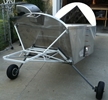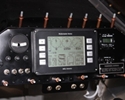


random user submitted photo
Tach pickup using alternator output (AeroVee & Jabiru)
1 post
• Page 1 of 1
Tach pickup using alternator output (AeroVee & Jabiru)
Both the AeroVee and Jabiru 2200/3300 engines use a permanent magnet alternator with two output wires coming from the alternator (actually a stator coil, but we use the term alternator somewhat interchangeably). These two wires are connected to the voltage rectifier/regulator (VR) to convert the raw AC output to a conditioned DC output suitable for our electrical system. Most EFIS/EIS type instruments can read the voltage pulse coming from the wires and translate that into an RPM reading.
There are several considerations to make this work.
First, both wires are typically identical, and either wire can be used for the tach signal. However, the terminals on the VR that the wires connect to are not the same. The VR used in the AeroVee only works with one of the two alternator terminals (it has to do with the way the VR is designed internally). You might be able to determine which terminal will work by examining the VR closely, but there's no harm in picking one terminal and trying, then swapping terminals if that first one doesn't output the signal.
Second, the EFIS/EIS must be programmed to properly interpret the signal it receives from the alternator. This is typically a user-programmed setting in the EFIS/EIS, and is often referred to as "pulses per revolution". For both the AeroVee and Jabiru it is 6 pulses (although some very old Jabiru engines used different alternators with 5 pulses). Some EFIS have a hi/low sensitivity setting, and some experimentation may be needed to find the right setting. Some EFIS require a resistor in the the tach wire (not the alternator wire) to prevent an unsteady rpm reading at high RPM. Resistors values are typically 10k-ohm.
Lastly, you may lose rpm indication if you switch off the alternator output, depending on your electrical system design. Switching between ignitions during a mag check shouldn't cause any problem, but anything that affects the alternator could interrupt your tach reading.
Jeff
There are several considerations to make this work.
First, both wires are typically identical, and either wire can be used for the tach signal. However, the terminals on the VR that the wires connect to are not the same. The VR used in the AeroVee only works with one of the two alternator terminals (it has to do with the way the VR is designed internally). You might be able to determine which terminal will work by examining the VR closely, but there's no harm in picking one terminal and trying, then swapping terminals if that first one doesn't output the signal.
Second, the EFIS/EIS must be programmed to properly interpret the signal it receives from the alternator. This is typically a user-programmed setting in the EFIS/EIS, and is often referred to as "pulses per revolution". For both the AeroVee and Jabiru it is 6 pulses (although some very old Jabiru engines used different alternators with 5 pulses). Some EFIS have a hi/low sensitivity setting, and some experimentation may be needed to find the right setting. Some EFIS require a resistor in the the tach wire (not the alternator wire) to prevent an unsteady rpm reading at high RPM. Resistors values are typically 10k-ohm.
Lastly, you may lose rpm indication if you switch off the alternator output, depending on your electrical system design. Switching between ignitions during a mag check shouldn't cause any problem, but anything that affects the alternator could interrupt your tach reading.
Jeff
- sonex1374
- Posts: 605
- Joined: Thu Mar 27, 2014 1:02 am
1 post
• Page 1 of 1
Return to Avionics and Instruments
Who is online
Users browsing this forum: No registered users and 1 guest







